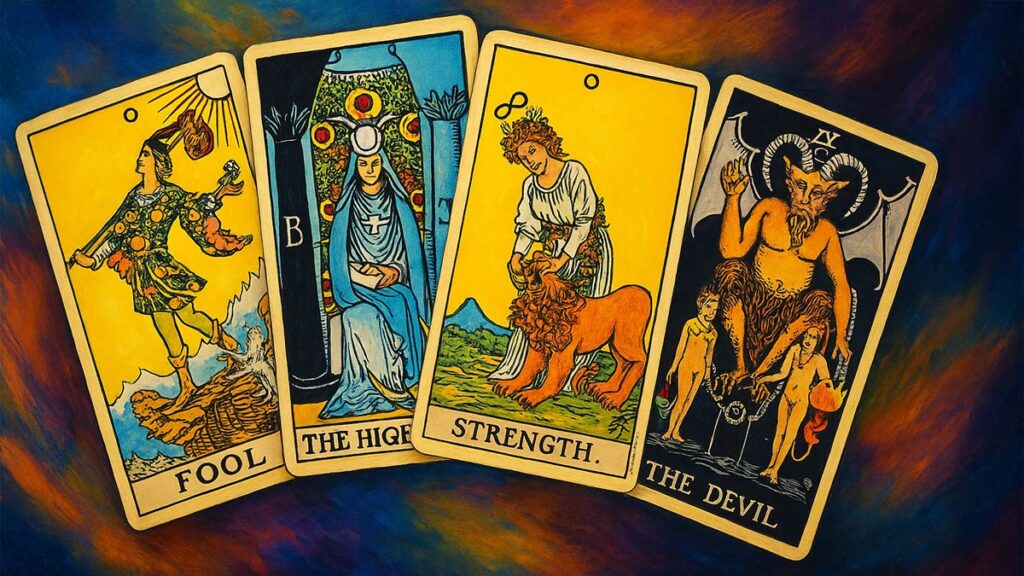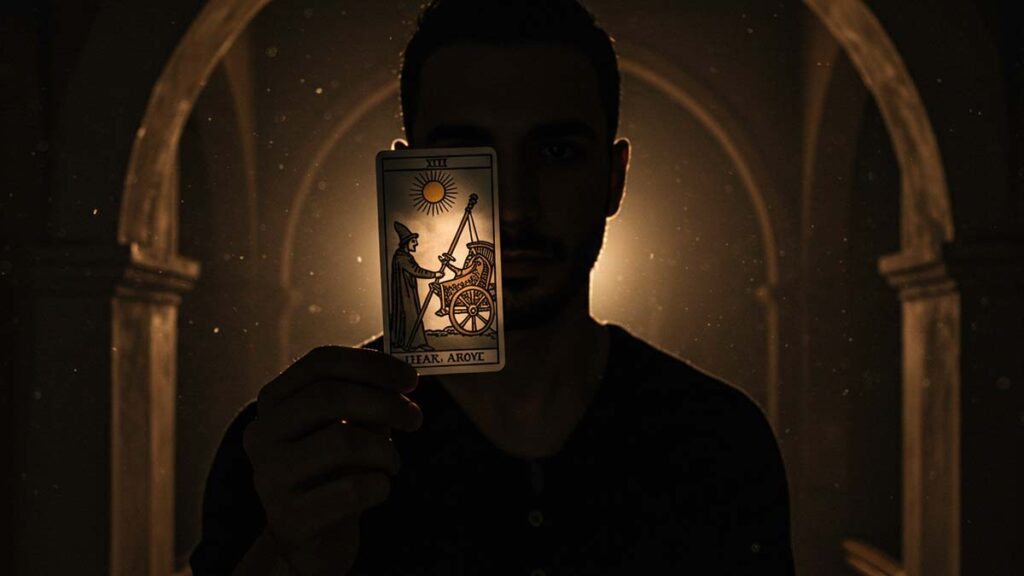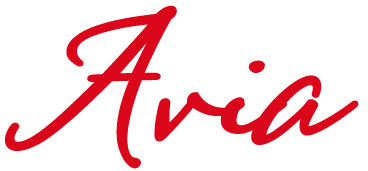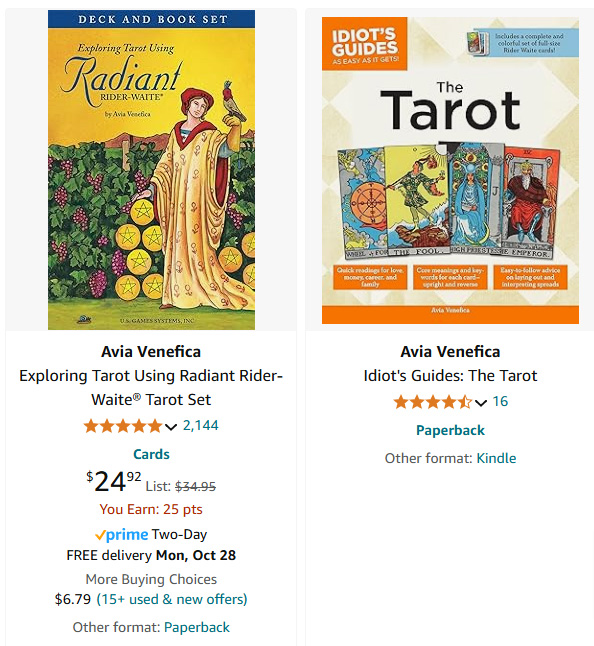Have you ever pulled a tarot card and felt like it was staring straight into your soul? Not just describing a situation, but naming a deep, inner truth you’ve been dancing around for years? Yeah. That’s archetypes in action. But what does that really mean? What are the tarot archetypes meanings? I’ve got answers.
Archetypes are the OG characters of the human experience, deep-rooted, symbolic patterns of behavior, personality, and story that show up across every culture, every myth, and yep, every tarot deck. Think of them like the universal roles we all play at different points in our lives: the Fool setting out on a journey, the Magician tapping into inner power, the Tower crumbling old structures so new ones can rise. Sound familiar? That’s because archetypes are us, only magnified and even mythologized.
The term “archetype” was made popular by Carl Jung, the Swiss psychiatrist who believed we all carry a set of shared symbols in our collective unconscious. He was talking about things like the Hero, the Shadow, the Mother, the Sage. Sound like the Major Arcana to you? It should, because tarot cards are absolutely dripping with archetypal energy. And that’s where the magic happens.
Tarot archetypes are mirrors. They reflect where you are, what you’re wrestling with, and where you’re headed if you’re brave enough to listen. Understanding the tarot archetypes meaning helps you read the cards as personal development tools that help you drill down on growth, self-reflection, healing, and transformation.
If all this sounds as intriguing to you as it is for me, grab your deck. We’re going archetype diving.
Major Arcana as Archetypes of the Soul

The Major Arcana is like a soul map, or a cosmic syllabus. It’s akin to a 22-step personal evolution dance, choreographed by the universe and performed by (you guessed it) you.
If you’ve ever wondered why tarot feels so potent, so revealing, so weirdly accurate, it’s because these cards aren’t just snapshots of circumstance. They’re archetypes of the soul, eternal roles we all move through, sometimes in sequence, sometimes in cycles, always in growth.
Let’s start with a quick recap. The journey begins with The Fool (wide-eyed, heart open, ready to leap) and ends with The World, where everything comes full circle in hard-earned wholeness. In between? Lessons. Initiations. Faceplants. Big wins. Moments of raw truth and soul-level glow-ups. Each card from the Major Arcana embodies an archetype you’ll meet again and again in your life, your dreams, and your tarot spreads.
So why does this matter?
Because once you learn the major arcana archetypes explained in plain language, you can start spotting your own soul-stage. Are you the Seeker or the Sage today? The Lover or the Hermit? Maybe you’re in Tower-mode (oof), or maybe you’re basking in the Sun. Either way, the tarot is a reflection of your personal evolution in full symbolic technicolor.
Tarot Archetypes List: Major Arcana as Archetypes of the Soul
Here’s a quick-reference tarot archetypes list of the 22 Major Arcana, with suggested archetypal roles to help you tune in to the deeper meaning of each soul-stage:
Tarot Archetypes List: Major Arcana as Archetypes of the Soul
| Tarot Card | Archetype Description |
|---|---|
| 0. The Fool | The Innocent / The Seeker |
| I. The Magician | The Manifestor / The Alchemist |
| II. The High Priestess | The Mystic / The Intuitive Guide |
| III. The Empress | The Nurturer / The Divine Feminine |
| IV. The Emperor | The Authority / The Father |
| V. The Hierophant | The Mentor / The Spiritual Teacher |
| VI. The Lovers | The Beloved / The Union-Maker |
| VII. The Chariot | The Warrior / The Willful Achiever |
| VIII. Strength | The Inner Power / The Compassionate Hero |
| IX. The Hermit | The Wise One / The Seeker of Truth |
| X. Wheel of Fortune | The Game-Changer / The Catalyst |
| XI. Justice | The Judge / The Truth-Bringer |
| XII. The Hanged Man | The Martyr / The Surrendered One |
| XIII. Death | The Transformer / The Releaser |
| XIV. Temperance | The Alchemist / The Harmonizer |
| XV. The Devil | The Shadow / The Tempter |
| XVI. The Tower | The Disruptor / The Awakener |
| XVII. The Star | The Healer / The Hope-Bringer |
| XVIII. The Moon | The Dreamer / The Subconscious Navigator |
| XIX. The Sun | The Radiant Self / The Child of Joy |
| XX. Judgment | The Redeemed / The Awakening Soul |
| XXI. The World | The Whole Self / The Cosmic Dancer |
Noteworthy point: These archetypes aren’t static. They evolve as you do. One week you’re in full-on Chariot mode, making moves and taking names. The next, you’re in Hermit mode, hoarding tea and truth in your cozy cave. That’s the beauty of the tarot: it doesn’t trap you in an identity but can help reveal the one you’re growing into. I think that’s a profound takeaway…that we are not unchanging automatons, we are fluid, and the tarot reflects that.
So keep this table close as we journey through more archetypes ahead. Each one has something to teach you about who you are, what you’re healing, and where you’re headed.
Deep Dive into the Hero Archetype in Tarot
Let’s talk about the Hero. It’s been bandied about (as in the popular “Hero’s Journey” written by Joseph Campbell that’s been a template from everything to manga to self-help books) This archetype isn’t necessarily not the sword-swinging, cape-wearing kind (though, hey, if that’s your vibe, rock it). I’m talking about the soul-level Hero. The part of you that gets knocked down seven times and gets up eight. The part that says, “I have no idea where this is going, but I have to go anyway.”
That’s the Hero archetype in tarot. And spoiler alert: it’s you, babe.
The Hero archetype is the beating heart of the tarot’s journey. It shows up early, loud, and often. We meet the Hero first in The Fool, that brave, banana-packing dreamer who steps off the cliff without a parachute. But the Hero evolves as the journey unfolds. In The Chariot, the Hero learns discipline, direction, and divine will. By the time we hit Strength, the Hero isn’t flexing muscles; it’s mastering emotional resilience and self-control. The lion is tamed not with force, but with inner calm.
So, what’s the deeper takeaway here?
The Hero archetype is about recognizing that you are the dragon, and the knight, and the healer who stitches the whole thing back together afterward. It’s about transformation, real, gritty, shake-you-by-the-shoulders kind of transformation.
That’s why when we talk about tarot archetypes and transformation, the Hero leads the charge. Every time you face fear, navigate change, or leap into the unknown with nothing but instinct and a half-charged phone battery, you’re living your Hero story.
Reflection Prompts: Your Inner Hero Awakens
Pull out your tarot journal, favorite pen, and maybe a snack (deep work requires snacks). Then try these questions:
- What chapter of the Hero’s journey am I in right now? (Beginning, challenge, triumph, or integration?)
- When was the last time I took a leap of faith like The Fool? What did I learn?
- Where do I need to summon my inner Chariot: focused, bold, and in control?
- What would Strength do if she were sitting in my shoes today?
And here’s a fun bonus:
Shuffle your deck. Ask: “What aspect of the Hero is calling to me right now?”
Pull a single card. Let it speak. Write down what it stirs in you. Let it surprise you.
The Hero archetype is dynamic, messy, and magnificent. It’s not about always knowing what you’re doing. Rather, it’s about doing it anyway, fueled by trust, curiosity, and a spark that refuses to die.
So whether you’re battling imposter syndrome, starting a business, ending a toxic cycle, or just trying to get through Tuesday, the Hero is with you. And better yet? The Hero is you.
Exploring the Shadow Archetype in Tarot

Let’s get one thing straight: the Shadow isn’t the villain in your story. It’s the misunderstood antihero wearing a hoodie in the back of your psyche, silently waiting for you to stop pretending you’re all love-and-light, and finally say, “Okay… let’s talk.”
The Shadow archetype in tarot is the part of you that’s raw, reactive, and real. It’s fear, shame, desire, jealousy, rage, and the ancient, buried gold that’s hidden beneath all that gunk. It’s not bad. It’s just… ignored. And like anything ignored for too long, it gets loud.
In the tarot, the Shadow shows up in all its mysterious glory in cards like:
- The Devil – Temptation, obsession, power plays, addiction to what isn’t good for you but tastes like freedom.
- The Moon – Illusions, projection, anxiety, emotional fog, and that sneaky inner saboteur.
- Death – Not actual death (usually), but ego-death, endings, and the terrifying freedom of letting go.
These are the shadow archetype tarot cards, and they don’t mess around. But they also don’t show up to punish you. They show up to liberate you.
And trust me: when you invite the Shadow to sit at the table instead of trying to shove it in the basement, things start to change. Fast.
Shadow Work & Tarot Archetypes in Relationships
Let’s be real. Nothing activates the Shadow like other people. The tarot archetypes in relationships often show us the parts of ourselves we’ve been denying. That controlling partner? Might be mirroring your fear of vulnerability. That situationship? Could be illuminating your discomfort with real intimacy. The Devil card isn’t just about sex and scandal (though, whew, it can be); it’s about patterns of entrapment that stem from unacknowledged wounds.
Embrace the Shadow = Reclaim Your Power
The gift of the Shadow is wholeness. When you embrace it (when you stop labeling parts of yourself as “bad” and start saying, “Oh hey, I see you, and I’m still worthy”), you unlock a deeper self-love than any Hallmark card could ever contain.
And let’s be honest: real transformation doesn’t come from chasing light. It comes from integrating the dark.
Here’s your invitation:
- What parts of yourself have you labeled as unworthy, unloveable, or too much?
- What’s the emotion you’ve been afraid to feel fully?
- Who or what triggers your Shadow, and what secret gift might be buried inside that trigger?
Pull your tarot deck. Ask the cards:
“What aspect of my Shadow is ready to be seen and healed?”
Then light a candle, take a deep breath, and listen with your whole heart.
The Shadow doesn’t want to destroy you. It wants to free you. And it’s only scary when it’s hidden.
So bring it into the light. Let it teach you. Let it transform you.
The Mentor Archetype: Guidance from Within

We’ve faced the Hero. We’ve danced with the Shadow. Now it’s time to sit cross-legged by the fire and listen to the one who knows: the Mentor.
In tarot, the mentor archetype isn’t some external guru with a beard and an echo chamber. It’s the you who already knows. The version of you that’s been through the wringer, kissed the chaos, journaled it all out, and came back with wisdom.
This archetype shows up when it’s time to pause the hustle and listen inward. Because, real talk? You don’t need another TikTok hack or cosmic download. You need stillness. You need self-trust. You need the mentor within.
Let’s meet the tarot cards who carry this archetypal vibe like it’s etched into their DNA:
Tarot Cards That Embody the Mentor Archetype
- The Hermit – The classic inner guide. Lantern in hand, retreating not to escape but to reflect. The Hermit says: “Stillness is sacred. Turn down the noise.”
- The High Priestess – Pure intuition, sacred knowledge, moonlight mystery. She waits for you to get quiet enough to hear her.
- The Hierophant – At first glance, he’s all structure and tradition. But dig deeper, and he’s the bridge between spiritual insight and real-life application. Less dogma, more decoding the sacred in the everyday.
Using Tarot Archetypes for Self-Development
The mentor archetype tarot isn’t about being “better” or more “spiritual.” It’s about integration. It’s about checking in with the you who doesn’t need external validation. It’s about radical self-honesty, and building a spiritual toolbox that works for you.
Tarot Practices to Channel the Mentor Within
Here’s how to start using tarot archetypes for self-development in real, grounded, soul-nourishing ways:
Tarot Journaling Prompt:
- Pull one of the mentor cards (Hermit, High Priestess, Hierophant) or ask: “What lesson is my inner guide trying to teach me right now?”
- Write a letter to yourself from the mentor. Let that wise part of you speak freely. No filter. No fear.
Meditative Visualization:
- Imagine yourself walking through a misty forest or sacred temple. You come across the Hermit’s lantern… or the High Priestess’s scroll… or the Hierophant’s sacred key.
- Ask a question you’ve been wrestling with. Listen to the answer (not with your ears, but with your intuition).
- Jot down what you receive, no matter how small or symbolic it seems.
Create a Spread:
Build a 3-card “Mentor Message” spread:
- What wisdom is available to me right now?
- What inner truth am I resisting?
- How can I best honor my inner guide?
Use it often. Watch how the answers deepen over time. That’s growth, baby.
The Mentor archetype isn’t here to tell you what to do. They’re here to remind you: You already know. Your inner guide has receipts, life experience, and the audacity to love you even when you’re a hot mess in yesterday’s pajamas.
Archetypes in the Minor Arcana
The Minor Arcana doesn’t always get the same mystical street cred as the Majors, but that’s like saying side quests aren’t important in an epic story. The Majors might define the soul’s journey, but the Minors? They narrate your daily drama, from spilled coffee to emotional epiphanies. And yes, archetypes live here, too. Loudly.
The tarot minor arcana archetype roles play out in all the tiny (but powerful) moments that shape your day-to-day life. The errands, the arguments, the text messages you rewrite six times but never send. These cards are packed with personalities, and each one holds an archetype ready to show you something important.
Court Card Archetypes: The Tarot’s Cast of Characters
Court cards equal mini archetypes in their own right. Each one reflects a style, a phase, or a persona you might embody (or encounter) in your daily life.
Here’s a quick vibe check on a few crowd favorites:
- Queen of Swords → The Intellect. Sharp as a tack, zero fluff. She speaks truth even if it cuts—but only because she’s been through the fire and came out knowing what matters.
- Knight of Cups → The Romantic. Think open-hearted, rose-colored-glasses energy. Loves deeply, dreams boldly… and sometimes forgets to return your texts.
- Page of Pentacles → The Student. Eager, grounded, always ready to learn. Budgeting spreadsheets and seed catalogs? Yes, please.
- King of Wands → The Visionary. Think bold leadership, charisma, and just enough chaos to keep it interesting. Lights fires (metaphorically… usually).
When you recognize these archetypes, you stop seeing the cards as static. They become dynamic mirrors, reflecting who you are, what you’re navigating, or who’s crossing your path.
Archetypes by Suit: Daily Energy & Identity
Each suit carries its own flavor of archetypal energy:
- Wands → The Creators, Rebels, and Action-Takers. (Think Entrepreneurs, Artists, Spiritual Trailblazers.)
- Cups → The Feelers, Lovers, and Healers. (The Empaths, Poets, Relationship Architects.)
- Swords → The Thinkers, Strategists, and Truth-Speakers. (Journalists, Critics, Logicians—hello, Queen of Swords.)
- Pentacles → The Builders, Nurturers, and Grounded Guardians. (Farmers, Accountants, DIYers, and caretakers of sacred routines.)
How to Spot Archetypes in Daily Readings
Here’s how to start making these archetypal connections like a boss:
1-Card Check-In:
Ask: “What archetype am I embodying today?” Pull one card. Don’t overthink it. Let it speak.
Pattern Watch:
Notice which court cards or suits show up for you repeatedly. That’s not a coincidence; it’s a cosmic theme. Is the Queen of Cups haunting your spreads? Maybe it’s time to nurture your emotional side. Seeing the Knight of Swords on repeat? Time to channel that energy… or slow your roll.
Role Reflection Prompt:
Write: “Which minor arcana archetype best represents me this week, and why?” Then answer it like you’re writing your own tarot character bio.
The Minor Arcana might seem, well… minor. But they hold major insight when you start looking through the lens of an archetype. These cards capture the messy, beautiful, real-life moments that make up your story. And when you see the archetypes inside them?
Combining Archetypes for Insight & Transformation
Okay, so you’ve met the Hero. Faced the Shadow. Channeled the Mentor. You’ve danced with queens, knights, and maybe that wild-eyed Fool who lives rent-free in your readings. What now?
Now it’s time to connect the archetypal dots, because real growth doesn’t come from analyzing cards in isolation. It comes from seeing the interplay of archetypes in your life. That’s where tarot becomes more than a reading; it becomes a transformation tool.
When you begin using tarot archetypes for self-development, you stop asking, “What does this card mean?” and start asking, “How do these characters reflect where I’m growing, or where I’m stuck?”
That’s when the magic really starts.
The Dance of Archetypes: Why They Work Better Together

In any given spread, multiple archetypes show up, and they don’t just sit there politely. Oh no. They interact. They challenge each other. They team up. They clash like your inner Child and inner Critic at a family reunion.
Here’s a peek at how this plays out:
- The Fool + The High Priestess = You’re leaping forward, but your intuition’s whispering: Pause. Feel.
- The Devil + The Hermit = You’re caught in an unhealthy loop, but a deeper truth is ready to pull you inward to heal it.
- Knight of Wands + Queen of Pentacles = Big dreams and wild energy need grounding. One’s ready to race, the other’s pouring tea like, “Let’s think this through, darling.”
Tips for Working with Archetypes in a Growth-Focused Tarot Practice
If you want to take your tarot practice from cute-and-quirky to life-altering, here are a few ways to deepen your connection to archetypes:
1. Name the Archetypes
Don’t just say “The Lovers.” Ask: What role is this card playing in my story? Is it the Harmonizer? The Risk-Taker? The Mirror?
2. Look for Patterns
Which archetypes repeat in your spreads? That repetition is a neon sign from your inner self: “Hey! There’s work to be done here!”
3. Dialogue Between Cards
Imagine a conversation between the archetypes that show up. What would the Chariot say to the Hanged Man? What would the Queen of Cups whisper to the Devil? Write it out. Let it get weird.
4. Track Your Personal Archetypal Timeline
Keep a monthly log of the key archetypes that show up in your readings. Over time, you’ll see a story arc, a personal myth unfolding in real time.
Archetype Integration Spread
Here’s a 5-card Archetype Integration Spread you can use anytime you feel pulled in multiple directions or need clarity on how your inner crew of archetypes is working together (or not).
| Card Position | Prompt |
|---|---|
| 1. Dominant Archetype | Who am I embodying most strongly right now? |
| 2. Suppressed Archetype | What part of myself am I ignoring or undervaluing? |
| 3. Shadow Archetype | What inner fear or wound needs my attention? |
| 4. Mentor Archetype | What wisdom or guidance is trying to come through? |
| 5. Integration Path | How can I bring these archetypes into harmony and growth? |
Pro tip: After pulling the spread, journal answers as if each archetype is a voice or character within you. Let them speak. Let them teach.
This is where it all comes together. Tarot archetypes and transformation go hand-in-hand because once you understand the roles at play, you can start casting yourself consciously. No more letting the Shadow drive or the Fool trip over the same life lesson. You become the director. The integrator. The soul alchemist.
So don’t just pull cards. Pull yourself together—beautifully, imperfectly, powerfully—one archetype at a time.
Archetypes, Psychology & the Wisdom of Symbols
If you’ve ever wondered about the Jungian archetypes tarot comparison, pull up a seat, we’re about to cross the streams of psychology and symbolism.
Jung’s 12 Archetypes vs. Tarot’s Major Players
Let’s do a quick symbolic speed-date between Jung’s most famous archetypes and their tarot twins:
| Jungian Archetype | Tarot Equivalent |
|---|---|
| The Innocent | The Fool |
| The Hero | The Chariot, Strength, The Fool again (he multitasks) |
| The Caregiver | The Empress, Queen of Cups |
| The Ruler | The Emperor, King of Pentacles |
| The Sage | The Hermit, The High Priestess |
| The Magician | The Magician (easy one, thanks Carl) |
| The Outlaw / Rebel | The Tower, The Devil |
| The Lover | The Lovers, Knight of Cups |
| The Creator | Queen of Wands, Ace of Wands |
| The Explorer | The Fool (again), Knight of Wands |
| The Everyman | Page of Pentacles, 6 of Cups |
| The Jester | The Fool (yes, again. He’s busy!) |
Is this list a perfect one-to-one? Not exactly. Tarot is messier, more layered, more poetic. But the overlap is undeniable, and incredibly useful.
Tarot doesn’t just reflect Jung’s theory. It embodies it. Each card is like a Jungian inkblot soaked in symbolism. When you read the cards, you’re reading your own subconscious—out loud.
Conclusion: Why Archetypes in Tarot Matter
If you’ve made it this far, you already know this isn’t your average “pull a card, hope for magic” kind of experience. Tarot goes way deeper than predictions or party tricks. It’s a mirror. A map. A meaningful conversation between your conscious mind and the wise, wild, and sometimes wounded parts of you that live just beneath the surface.
Understanding tarot archetypes meaning is foundational. Whether you’re reading for yourself or others, archetypes give your readings depth, direction, and soul-level context. They help you name what’s hard to name. They help you hold space for contradictions (like being both the Hero and the Hermit). And they guide you toward growth, not by telling your future, but by revealing who you already are becoming.
And if you’re new to all this? Perfect.
This whole dance of tarot archetypes for beginners is actually perfect for any stage of your journey. Because tarot works like moving through a spiral. You’ll come back to the same archetypes again and again. But each time, you’ll meet them with new eyes, new wisdom, and maybe a little more self-love.
As always, thanks for reading!
Mighty brightly,

© Copyrighted. All rights reserved.

